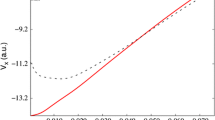Abstract
The Hohenberg-Kohn theorem plays a fundamental role in density functional theory, which has become the most popular and powerful computational approach to study the electronic structure of matter. In this article, we study the Hohenberg-Kohn theorem for a class of external potentials based on a unique continuation principle.
Similar content being viewed by others
References
Adams R A, Fournier J J F. Sobolev Spaces, 2nd ed. Amsterdam: Academic Press, 2003
Ayers P W, Golden S, Levy M. Generalizations of the Hohenberg-Kohn theorem, I: Legendre transform constructions of variational principles for density matrices and electron distrbution functions. J Chem Phys, 2006, 124: 054101
Boosting materials modelling. Nature Materials, 2016, 15: 365, http://www.nature.com/nmat/journal/v15/n4/pdf/ nmat4619.pdf
Eschrig H. The Fundamentals of Density Functional Theory. Leipzig: Eagle, 2003
Fournais S, Hoffmann-Ostenhof M, Hoffmann-Ostenhof T, et al. Positivity of the spherically averaged atomic oneelectron density. Math Z, 2008, 259: 123–130
Hadjisavvas N, Theophilou A. Rigorous formulation of the Kohn-Sham theory. Phys Rev A (3), 1984, 30: 2183–2186
Hohenberg P, Kohn W. The inhomogeneous electron gas. Phys Rev, 1964, 136: 864–871
Jerison D, Kenig C E. Unique continuation and absence of positive eigenvalues for Schrödinger operators. Ann of Math (2), 1985, 121: 463–494
Kohn W, Sham L J. Self-consistent equations including exchange and correlation effects. Phys Rev A, 1965, 140: 4743–4754
Kryachko E S. On the original proof by reductio ad absurdum of the Hohenberg-Kohn theorem for many-electron Coulomb systems. Int J Quantum Chem, 2005, 103: 818–823
Kryachko E S. On the proof by reductio ad absurdum of the Hohenberg-Kohn theorem for ensembles of fractionally occupied states of Coulomb systems. Int J Quantum Chem, 2006, 106: 1795–1798
Kryachko E S, Ludeñ E V. Density functional theory: Foundations reviewed. Phys Rep, 2014, 544: 123–239
Kvaal S, Helgaker T. Ground-state densities from the Rayleigh-Ritz variation principle and from density functional theory. J Chem Phys, 2015, 143: 184106
Lammert P E. Differentiability of Lieb functional in electronic density functional theory. Int J Quantum Chem, 2007, 107: 1943–1953
Levy M. University variational functionals of electron densities, first-order density matrices, and natural spin-orbitals and solutions of the v-representability problems. Proc Natl Acad Sci USA, 1979, 76: 6062–6065
Levy M. Electron densities in search of Hamiltonians. Phys Rev A, 1982, 26: 1200–1208
Lieb E H. Density functionals for Coulomb systems. Int J Quantum Chem, 1983, 24: 243–277
Martin R. Electronic Structure: Basic Theory and Practical Methods. London: Cambridge University Press, 2004
Parr R G, Yang W T. Density-Functional Theory of Atoms and Molecules. Oxford: Oxford University Press, 1989
Pino R, Bokanowski O, Ludexxxxxa E V, et al. A re-statement of the Hohenberg-Kohn theorem and its extension to finite subspaces. Theor Chem Account, 2007, 118: 557–561
Reed M, Simon B. Methods of Modern Mathematical Physics IV: Analysis of Operators. San Diego: Academic Press, 1978
Redner S. Citation statistics from 110 years of physical review. Physics Today, 2005, 58: 49–54
Schechter M, Simon B. Unique continuation for Schrodinger operators with unbounded potentials. J Math Anal Appl, 1980, 77: 482–492
Szczepanik W, Dulak M, Wesolowski T A. Comment on "On the original proof by reductio ad absurdum of the Hohenberg-Kohn theorem for many-electron Coulomb systems". Int J Quantum Chem, 2007, 107: 762–763
van Noorden R, Maher B, Nuzzo R. The top 100 papers. Nature, 2014, 514: 550–553
Wolff T H. Recent work on sharp estimates in second-order elliptic unique continuation problems. J Geom Anal, 1993, 3: 621–650
Zhou A. Hohenberg-Kohn theorem for Coulomb type systems and its generalization. J Math Chem, 2012, 50: 2746–2754
Zhou A. Some open mathematical problems in electronic structure models and calculations (in Chinese). Sci Sin Math, 2015, 45: 929–938
Acknowledgements
This work was supported by National Natural Science Foundation of China (Grant Nos. 91730302, 9133202 and 11671389), and the Key Research Program of Frontier Sciences of the Chinese Academy of Sciences (Grant No. QYZDJ-SSW-SYS010). The author thanks Mr. Bing Yang for the useful discussion on the unique continuation property and the anonymous referees for their careful reviews and helpful suggestions that improved the presentation of this paper.
Author information
Authors and Affiliations
Corresponding author
Rights and permissions
About this article
Cite this article
Zhou, A. A mathematical aspect of Hohenberg-Kohn theorem. Sci. China Math. 62, 63–68 (2019). https://doi.org/10.1007/s11425-018-9337-2
Received:
Accepted:
Published:
Issue Date:
DOI: https://doi.org/10.1007/s11425-018-9337-2




